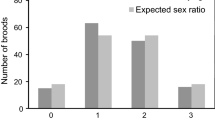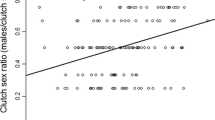Abstract
Sex ratio theory is one of the most controversial topics in evolutionary ecology. Many deviations from an equal production of males and females are reported in the literature, but few patterns appear to hold across species or populations. There is clearly a need to identify fitness effects of sex ratio variation. We studied this aspect in a population of a long-lived seabird, the wandering albatross (Diomedea exulans), using molecular sex-identification techniques. We report that parental traits affect both (1) fledgling traits in a sex-dependent way and (2) chick sex: Sons are overproduced when likely to be large at fledging and, to a lesser extent, daughters are overproduced when likely to be in good body condition at fledging. Because for the same population, a previous study reported that post-fledging survival was positively affected by size in males and by body condition in females, our results suggest that wandering albatrosses manipulate offspring sex to increase post-fledging survival.


Similar content being viewed by others
References
Appleby BM, Petty SJ, Blakey JK, Rainey P, MacDonald DW (1997) Does variation of sex ratio enhance reproductive success of offspring in tawny owls (Strix aluco)? Proc R Soc Lond B 264:1111–1116
Badyaev AV, Hill GE, Beck ML, Dervan AA, Duckworth RA, McGraw KJ, Nolan PM, Whittingham LA (2002) Sex-biased hatching order and adaptive population divergence in a passerine bird. Science 295:316–318
Barbraud C (2000) Natural selection on body size traits in a long-lived bird, the snow petrel Pagodroma nivea. J Evol Biol 13:81–88
Barbraud C, Weimerskirch H, Robertson GG, Jouventin P (1999) Size-related life history traits: insights from a study of snow petrels (Pagodroma nivea). J Anim Ecol 68:1179–1192
Blanchard P, Festa-Bianchet M, Gaillard J-M, Jorgenson JT (2005) Maternal condition and offspring sex in polygynous ungulates: a case study of bighorn sheep. Behav Ecol 16:274–279
Boulet M, Olsen P, Cockburn A, Newgrain K (2001) Parental investment in male and female offspring by the Peregrine Falcon, Falco peregrinus. Emu 101:95–103
Clutton-Brock TH (1986) Sex ratio variation in birds. Ibis 128:317–329
Clutton-Brock TH, Albon SD, Guinness FE (1986) Great expectations: dominance, breeding success and offspring sex ratios in red deer. Anim Behav 34:460–471
Daan S, Dijkstra C, Weissing FJ (1996) An evolutionary explanation for seasonal trends in avian sex ratio. Behav Ecol 7:426–430
Dijkstra C, Daan S, Buker JB (1990) Adaptive seasonal variation in the sex ratio of kestrel broods. Funct Ecol 4:143–147
Don RH, Cox PT, Wainwright BJ, Baker K, Mattick JS (1991) “Touchdown” PCR to circumvent spurious priming during gene amplification. Nucleic Acids Res 19:4008
Festa-Bianchet M (1996) Offspring sex ratio studies of mammals—Does publication depend upon the quality of the research or the direction of the results? Ecoscience 3:42–44
Festa-Bianchet M, Jorgenson JT, Réale D (2000) Early development, adult mass and reproductive success in bighorn sheep. Behav Ecol 11:633–639
Fletcher KL, Hamer KC (2004) Offspring sex ratio in the common tern Sterna hirundo, a species with negligible sexual size dimorphism. Ibis 146:454–460
Frank SA (1990) Sex allocation theory for birds and mammals. Ann Rev Ecol Syst 21:13–55
Fridolfsson AK, Ellegren H (1999) A simple and universal method for molecular sexing of non-ratite birds. J Avian Biol 30:116–121
Gonzáles-Solis J (2004) Sexual size dimorphism in northern giant petrels: ecological correlates and scaling. Oikos 105:247–254
Griffiths R, Double C, Orr K, Dawson R (1998) A DNA test to sex most birds. Mol Ecol 7:1071–1075
Hasselquist D, Kempenaers B (2002) Parental care and adaptive brood sex ratio manipulation in birds. Philos Trans R Soc Lond B 357:363–372
Heinsohn R, Legge S, Barry S (1997) Extreme bias in sex allocation in Eclectus parrots. Proc R Soc Lond B 264:1325–1329
Hewison AJM, Gaillard J-M (1999) Successful sons or advantaged daughters? The Trivers–Willard model and sex-biased maternal investment in ungulates. Trends Ecol Evol 14:229–234
Jouventin P, Lequette B, Dobson FS (1999) Age-related mate choice in the wandering albatross. Anim Behav 57:1099–1106
Kölliker M, Heeb P, Werner I, Mateman AC, Lessells CM, Richner H (1999) Offspring sex ratio is related to male body size in the great tit (Parus major). Behav Ecol 10:68–72
Komdeur J (1998) Long-term fitness benefits of egg sex modification by the Seychelles warbler. Ecol Lett 1:56–62
Komdeur J, Daan S, Tinbergen J, Mateman C (1997) Extreme adaptive modification in sex ratio of the Seychelles warbler’s eggs. Nature 385:522–525
Krackow S (1995) Potential mechanisms for sex ratio adjustment in mammals and birds. Biol Rev 70:225–241
Kruuk LEB, Clutton-Brock TH, Albon SD, Pemberton JM, Guinness FE (1999a) Population density affects sex ratio variation in red deer. Nature 399:459–461
Kruuk LEB, Clutton-Brock TH, Rose KE, Guiness FE (1999b) Early determinants of lifetime reproductive success differ between the sexes in red deer. Proc R Soc Lond B 266:1655–1661
Nager RG, Monaghan P, Griffiths R, Houston D, Dawson R (1999) Experimental demonstration that offspring sex ratio varies with maternal condition. Proc Natl Acad Sci USA 96:570–573
Nager RG, Monaghan P, Houston DC, Genovart M (2000) Parental condition, brood sex ratio and differential young survival: an experimental study in gulls (Larus fuscus). Behav Ecol Sociobiol 48:452–457
Pen I, Weissing FJ, Daan S (1999) Seasonal sex ratio trend in the European kestrel: an evolutionarily stable strategy analysis. Am Nat 153:384–397
Pike TW, Petrie M (2003) Potential mechanisms of avian sex manipulation. Biol Rev 78:553–574
R Development Core Team (2003) R: a language and environment for statistical computing Vienna: R Foundation for Statistical Computing
Radford AN, Blakey JK (2000) Is variation in brood sex ratios adaptive in the great tit (Parus major)? Behav Ecol 11:294–298
Sasvári L, Hegyi Z (2001) Condition-dependent parental effort and reproductive performance in the white stork Ciconia ciconia. Ardea 89:281–291
Shaffer SA, Weimerskirch H, Costa DP (2001) Functional significance of sexual dimorphism in wandering albatrosses, Diomedea exulans. Funct Ecol 15:203–210
Sheldon BC (1998) Recent studies of avian sex ratios. Heredity 80:397–402
Sheldon BC, West SA (2004) Maternal dominance, maternal condition, and offspring sex ratio in ungulate mammals. Am Nat 163:40–54
Trivers RL, Willard DE (1973) Natural selection of parental ability to vary the sex ratio of offspring. Science 79:90–91
Van Shaik CP, Hrdy SB (1991) Intensity of local resource competition shapes the relationship between maternal rank and sex ratios at birth in cercopithecine primates. Am Nat 138:1555–1562
Wang H, Qi M, Cutler AJ (1993) A simple method of preparing plant samples for PCR. Nucleic Acids Res 21:4153–4154
Wauters LA, Decrombrugghe SA, Nour N, Matthysen E (1995) Do female roe deer in good condition produce more sons than daughters. Behav Ecol Sociobiol 37:189–193
Weatherhead PJ, Teather KL (1991) Are skewed fledgling sex ratios in sexually dimorphic birds adaptive? Am Nat 138:1159–1172
Weimerskirch H, Lys P (2000) Seasonal changes in the provisioning behaviour and mass of male and female wandering albatrosses in relation to the growth of their chick. Polar Biol 23:733–744
Weimerskirch H, Brothers N, Jouventin P (1997a) Population dynamics of wandering albatross Diomedea exulans and Amsterdam albatross D. amsterdamensis in the Indian Ocean and their relationships with long-line fisheries: conservation implications. Biol Conserv 79:257–270
Weimerskirch H, Cherel Y, Cuenot-Chaillet F, Ridoux V (1997b) Alternative foraging strategies and resource allocation by male and female wandering albatrosses. Ecology 78:2051–2063
Weimerskirch H, Barbraud C, Lys P (2000) Sex differences in parental investment and chick growth in wandering albatrosses: fitness consequences. Ecology 81:309–318
Weimerskirch H, Lallemand J, Martin J (2005) Population sex ratio variation in a monogamous long-lived bird, the wandering albatross. J Anim Ecol 74:285–291
West SA, Reece SE, Sheldon BC (2002) Sex ratios. Heredity 88:117–124
Westerdahl H, Bensch S, Hansson S, Hasselquist B, Von Schantz T (1997) Sex ratio variation among broods of great reed warblers Acrocephalus arundinaceus. Mol Ecol 6:543–548
Whittingham LA, Dunn PO (2000) Offspring sex ratios in tree swallows: females in better condition produce more sons. Mol Ecol 9:1123–1129
Williams TD (1979) The question of adaptive sex ratio in outcrossed vertebrates. Proc R Soc Lond B 205:567–580
Acknowledgement
Frédéric Pawlowski, Amélie Robert, Jérôme Legrand and Caroline Dondelinger provided invaluable technical assistance in the field. We thank Dominique Besson for help with the data management and D. Allainé, C. Barbraud, S. Devillard, B. Doligez, M. Festa-Bianchet, J.-M. Gaillard, M. Garel, A. Loison, A. Million, J. O’Brien, B. van Moorter and two anonymous referees for helpful comments on the manuscript. The study was financed by IPEV (Institut Polaire Français—Paul Emile Victor—program no. 109) and the Ethic Committee of IPEV approved the field procedure.
Author information
Authors and Affiliations
Corresponding author
Additional information
Communicated by I. Hartley
Rights and permissions
About this article
Cite this article
Blanchard, P., Hanuise, N., Dano, S. et al. Offspring sex ratio in relation to parental structural size and body condition in the long-lived wandering albatross (Diomedea exulans). Behav Ecol Sociobiol 61, 767–773 (2007). https://doi.org/10.1007/s00265-006-0307-9
Received:
Revised:
Accepted:
Published:
Issue Date:
DOI: https://doi.org/10.1007/s00265-006-0307-9




